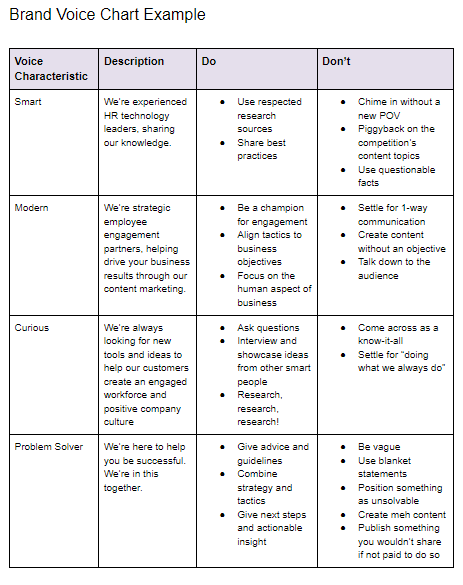Establishing a strong brand identity is crucial for capturing the attention and loyalty of your target audience. One of the most essential elements of a brand’s identity is its voice – the unique personality, tone, and style that shines through in all of its communications. A distinct brand voice sets you apart from competitors, builds trust with your audience, and creates a memorable and consistent experience across various marketing channels.

The Importance of a Distinct Brand Voice
- Differentiation: A unique brand voice helps you stand out in a crowded market by creating a memorable and recognizable persona that resonates with your target audience.
- Trust and Credibility: Consistency in your brand voice builds trust and credibility with your audience, as they come to associate your brand with a specific personality and set of values.
- Emotional Connection: A well-crafted brand voice allows you to connect with your audience on an emotional level, fostering loyalty and long-term relationships.
- Improved Brand Recall: A distinct brand voice makes your brand more memorable, increasing the likelihood that your target audience will recall your brand when making purchasing decisions.
The first step in developing your brand voice is to define your brand personality. This involves identifying the key characteristics and values that embody your brand’s essence. Start by asking yourself, “If my brand were a person, what kind of personality would they have?” Would they be fun and playful, always ready with a joke or a witty comment? Or would they be serious and authoritative, exuding confidence and expertise in their field?
To answer these questions, consider your brand’s mission statement, target audience, and unique selling proposition. Your mission statement should provide insight into your brand’s core values and purpose, which can help guide your brand personality. For example, if your mission is to provide eco-friendly and sustainable products, your brand personality may be caring, conscientious, and socially responsible.
Your target audience is another critical factor in shaping your brand personality. Consider their demographics, interests, and pain points. What kind of personality would resonate with them and make them feel understood and appreciated? If your target audience is primarily young, tech-savvy professionals, your brand personality may be innovative, forward-thinking, and slightly irreverent.
Your unique selling proposition (USP) can help differentiate your brand personality from competitors. If your USP is based on exceptional customer service, your brand personality may be friendly, empathetic, and always willing to go the extra mile.
By carefully considering these factors, you can craft a brand personality that is authentic, memorable, and resonates with your target audience.
Create a Brand Voice Chart
Once you have defined your brand personality, the next step is to create a brand voice chart. This tool outlines the specific traits, tone, and language that embody your brand voice, serving as a reference for all team members involved in creating content and communications.
Your brand voice chart should include several key elements. First, list the primary characteristics of your brand personality, such as “friendly,” “informative,” or “ambitious.” Next, describe your brand’s tone – is it casual and conversational, or formal and professional? Provide examples of how this tone translates into your writing style, such as using contractions and simple language for a casual tone, or using industry-specific terminology and complex sentence structures for a more formal tone.
Content Marketing Institute has a great Brand Voice Chart example.

Maintaining Consistency Across Marketing Channels
Develop Brand Voice Guidelines
Once you have established your brand voice, it’s essential to create a comprehensive set of guidelines that outline your brand’s tone, language, and messaging. These guidelines serve as a reference for all team members involved in creating content and communications, ensuring that your brand voice remains consistent across all marketing channels.
Your brand voice guidelines should include a detailed description of your brand personality, including the key characteristics and values that define your brand. It should also provide examples of the tone and language that embody your brand voice, such as the use of contractions, industry-specific terminology, and any words or phrases to avoid.
In addition to these general guidelines, your brand voice document should also include specific guidelines for each marketing channel. For example, your social media guidelines may specify the use of hashtags, emojis, and a more casual tone, while your email marketing guidelines may focus on a more formal and informative tone.
It’s important to make your brand voice guidelines easily accessible to all team members, such as by storing them in a shared folder or on your company’s intranet. As your brand evolves over time, be sure to regularly update your guidelines to reflect any changes in your brand personality or messaging.
Train Your Team
To ensure that your brand voice is consistently applied across all marketing channels, it’s crucial to provide regular training and support to all team members involved in creating content and communications. This includes not only your marketing team but also any other departments that may contribute to your brand’s messaging, such as sales, customer service, and product development.
Start by providing a comprehensive overview of your brand voice guidelines to all team members, including the key characteristics, tone, and language that define your brand personality. Use examples of on-brand content to illustrate how these guidelines translate into practice.
In addition to this initial training, consider providing regular workshops and refresher sessions to reinforce the importance of consistency and address any questions or concerns that may arise over time. These sessions can also be an opportunity to share best practices and celebrate examples of particularly effective on-brand content.
To further support your team, consider creating a brand voice quiz or checklist that team members can use to evaluate their content and ensure that it aligns with your brand voice guidelines. This can be a helpful tool for catching any inconsistencies or areas for improvement before content is published.

Assign a Brand Voice Champion
To help ensure that your brand voice is consistently applied across all marketing channels, it can be helpful to designate a team member as your brand voice champion. This person is responsible for overseeing the implementation of your brand voice guidelines and serving as a resource for other team members.
Your brand voice champion should have a deep understanding of your brand personality and be able to articulate your brand voice guidelines clearly and effectively. They should also have strong communication and leadership skills, as they will be responsible for providing feedback and guidance to other team members.
Some of the key responsibilities of your brand voice champion may include:
- Reviewing all content and communications before they are published to ensure that they align with your brand voice guidelines
- Providing feedback and suggestions for improvement to team members who may be struggling to apply your brand voice consistently
- Identifying opportunities for improvement and updating your brand voice guidelines as needed
- Serving as a liaison between your marketing team and other departments to ensure that your brand voice is consistently applied across all touchpoints
- Monitoring your brand voice across all marketing channels and reporting on any inconsistencies or areas for improvement
By designating a brand voice champion, you can help ensure that your brand voice remains consistent and effective over time, even as your team and marketing efforts evolve.
Create Channel-Specific Guidelines
While your overall brand voice should remain consistent across all marketing channels, it’s important to recognize that each channel has its own unique requirements and best practices. To ensure that your brand voice is effectively adapted to each channel, consider creating channel-specific guidelines that provide more detailed guidance on tone, language, and messaging.
For example, your social media guidelines may specify the use of a more casual and conversational tone, as well as the use of hashtags, emojis, and other platform-specific features. Your guidelines may also include recommendations for the types of content that perform best on each platform, such as short-form videos on TikTok or long-form articles on LinkedIn.
Your email marketing guidelines, on the other hand, may focus on a more formal and informative tone, with a greater emphasis on providing value to your subscribers. Your guidelines may include recommendations for subject lines, call-to-action buttons, and other elements that can impact the effectiveness of your email campaigns.
By creating channel-specific guidelines, you can help ensure that your brand voice is effectively adapted to the unique requirements and best practices of each marketing channel. This can help improve the effectiveness of your marketing efforts and ensure that your brand voice remains consistent and recognizable across all touchpoints.
Use Templates and Examples
To help your team consistently apply your brand voice across all marketing channels, consider providing templates and examples of on-brand content. These resources can serve as a starting point for creating new content and help ensure that all communications align with your brand voice guidelines.
Your templates may include things like:
- Email templates that demonstrate the appropriate tone, language, and formatting for different types of communications (e.g., newsletters, promotional emails, transactional emails)
- Social media post templates that showcase the ideal length, tone, and messaging for each platform
- Blog post templates that outline the appropriate structure, tone, and formatting for different types of content (e.g., how-to articles, opinion pieces, interviews)
- Ad copy templates that demonstrate the appropriate tone, language, and messaging for different types of campaigns (e.g., awareness, consideration, conversion)
In addition to templates, consider providing examples of particularly effective on-brand content. These examples can serve as a source of inspiration and guidance for your team and help illustrate how your brand voice guidelines translate into practice.
By providing templates and examples, you can streamline the content creation process and ensure that all communications are consistent and effective in representing your brand voice.
Monitor and Analyze
Finally, to ensure that your brand voice remains consistent and effective over time, it’s important to regularly monitor and analyze your marketing efforts. This involves tracking key metrics and gathering feedback from your audience to identify areas for improvement and optimize your brand voice strategy.
Some of the key metrics you may want to track include:
- Engagement rates: How many people are interacting with your content (e.g., likes, comments, shares)?
- Reach: How many people are seeing your content?
- Sentiment: How are people reacting to your content (e.g., positive, negative, neutral)?
- Conversion rates: How many people are taking the desired action (e.g., making a purchase, signing up for a newsletter)?
In addition to tracking these quantitative metrics, it’s also important to gather qualitative feedback from your audience. This may involve conducting surveys, focus groups, or social listening to understand how people perceive your brand voice and identify any areas for improvement.
Based on the insights you gather from monitoring and analyzing your marketing efforts, you can make data-driven adjustments to your brand voice strategy. This may involve tweaking your tone or messaging, experimenting with new types of content, or adjusting your approach to specific marketing channels.
By regularly monitoring and analyzing your brand voice, you can ensure that it remains effective and resonant with your target audience over time. This can help you build a stronger, more recognizable brand identity and drive better results from your marketing efforts.
Best Practices for Specific Marketing Channels
- Website:
- Ensure that your website copy, design, and user experience align with your brand voice.
- Use consistent messaging and tone across all pages, from your homepage to your product descriptions.
- Incorporate your brand voice into your website’s meta titles, descriptions, and alt tags for improved SEO.
- Social Media:
- Adapt your brand voice to suit the unique characteristics of each social media platform (e.g., LinkedIn vs. Instagram).
- Engage with your audience using a consistent tone and personality, while being responsive to their comments and questions.
- Use visuals, such as images and videos, that align with your brand voice and aesthetic.
- Email Marketing:
- Maintain a consistent brand voice across all email communications, from newsletters to promotional campaigns.
- Segment your email list to deliver targeted content that resonates with specific audience groups.
- Use a recognizable sender name and email template design that reinforces your brand identity.
- Content Marketing:
- Ensure that your blog posts, articles, and other content pieces align with your brand voice and provide value to your target audience.
- Use a consistent writing style, tone, and formatting across all content pieces.
- Incorporate your brand voice into your content’s headlines, subheadings, and calls-to-action.
- Advertising:
- Develop ad copy and visuals that align with your brand voice and capture the attention of your target audience.
- Maintain consistency across various advertising channels, such as display ads, social media ads, and search engine marketing.
- Use A/B testing to optimize your ad performance and ensure that your brand voice resonates with your audience.
Measuring the Success of Your Brand Voice
- Brand Awareness: Track metrics such as website traffic, social media followers, and brand mentions to gauge the impact of your brand voice on overall brand awareness.
- Engagement: Monitor engagement metrics, such as likes, comments, shares, and email open rates, to determine how well your brand voice resonates with your audience.
- Customer Feedback: Solicit feedback from your customers through surveys, reviews, and social media interactions to gain insights into how your brand voice is perceived.
- Sales and Revenue: Ultimately, the success of your brand voice will be reflected in your bottom line. Track sales and revenue metrics to determine the impact of your brand voice on your business’s financial performance.
Developing a distinct brand voice is a critical component of building a strong and memorable brand identity. By crafting a unique personality, tone, and style that resonates with your target audience, you can differentiate your brand from competitors, build trust and credibility, and foster long-term relationships with your customers. Maintaining consistency across all marketing channels is essential for reinforcing your brand voice and creating a cohesive experience for your audience.






